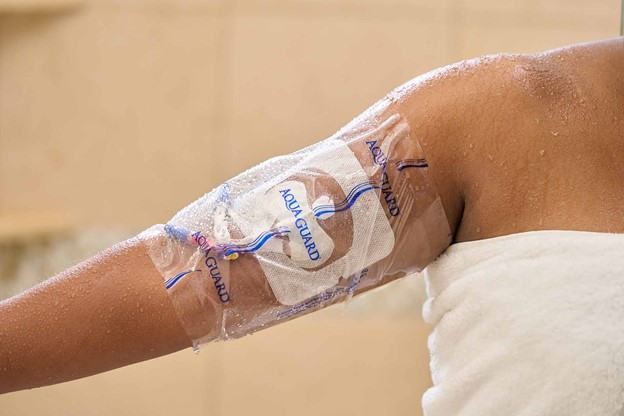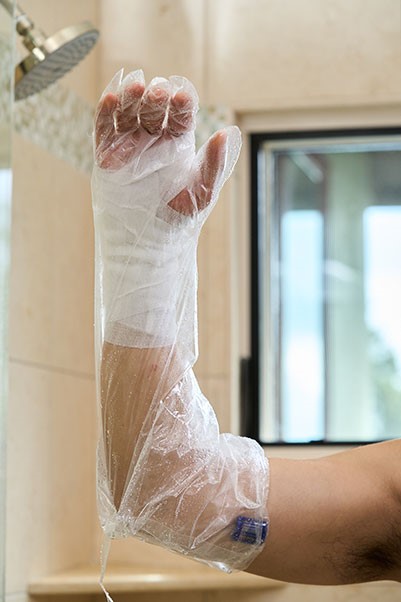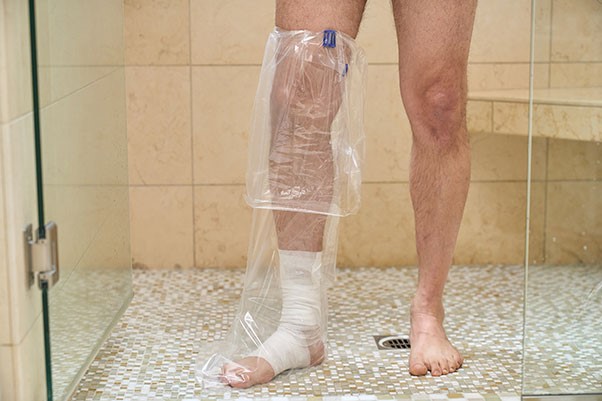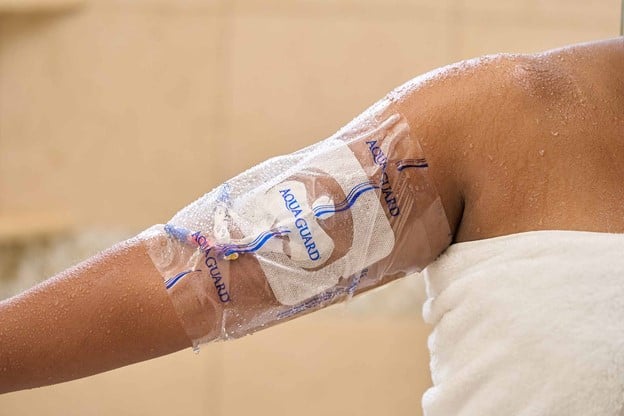Single-Use Moisture Barriers Help Preserve the Integrity of Wound Dressings
 TIDI Products’ AquaGuard® single-use moisture barriers have been designed to keep wounds, dressings, intravenous sites, and orthopedic casts dry during showers. In doing so, AquaGuard helps minimize the number of dressing changes attributable to excessive exposure to water and moisture.
TIDI Products’ AquaGuard® single-use moisture barriers have been designed to keep wounds, dressings, intravenous sites, and orthopedic casts dry during showers. In doing so, AquaGuard helps minimize the number of dressing changes attributable to excessive exposure to water and moisture.
Leaving a wound dressing intact and in place for a longer period could have clinical benefits by reducing dressing-change−associated trauma to the wound and avoiding unnecessary exposure of the wound to possible external contaminants.1 Higher dressing change frequency may lead to an increased risk of dangerous and costly complications, including surgical site infections (SSI) and infections of chronic wounds (e.g., diabetic ulcers).1,2
The three AquaGuard products discussed in the sections below provide a convenient and effective way to protect wound dressings from moisture. AquaGuard is used in hospitals and long-term care facilities, as well as for home healthcare.
(1) AquaGuard Sheet Shower Covers
AquaGuard sheet shower covers can be applied to the torso, arm, or leg by either a caregiver or a patient. Made with waterproof material, these self-adhesive sheets help keep wounds, dressings, and intravenous sites dry when showering. Common applications include PICC lines, ports, subclavian and internal jugular sites, and small surgical sites.
Each AquaGuard sheet consists of an occlusive polyethylene barrier with a border that uses a specially designed medical adhesive to allow gentle removal afterward. Unlike improvised solutions, AquaGuard sheets are convenient, ready to apply, and optimized for use in the shower.
Sheet sizes ranging from 4” x 4” up to 12” x 24” offer appropriate coverage for areas of concern. Single-use AquaGuard sheet shower covers are hypoallergenic, made without latex, and gentle on skin.
(2) AquaGuard Shower Glove
 The AquaGuard Glove® is an arm shower sleeve that helps keep PICC lines, peripheral intravenous sites, orthopedic casts, wounds, dressings, and surgical sites dry during showers. Each 34” single-use shower glove is made with waterproof material and provides hand, wrist, elbow, and arm coverage.
The AquaGuard Glove® is an arm shower sleeve that helps keep PICC lines, peripheral intravenous sites, orthopedic casts, wounds, dressings, and surgical sites dry during showers. Each 34” single-use shower glove is made with waterproof material and provides hand, wrist, elbow, and arm coverage.
Instead of adhesive, this arm-length shower sleeve uses a convenient Water-Seal Band® with a simple auto-locking buckle. The full-sleeve shower glove can be applied by a caregiver or a patient and allows the covered arm to move as it normally would while showering. Like the sheet shower covers described in the previous section, the AquaGuard Glove is hypoallergenic, made without latex, and gentle on skin.
(3) AquaGuard Shower Boot

The AquaGuard Boot® is a leg shower sleeve that helps keep surgical sites, diabetic ulcers, wounds, dressings, and orthopedic casts and appliances dry during showers. Each 43” single-use shower boot is made with waterproof material and provides foot, ankle, knee, and lower-thigh coverage.
This full-leg sleeve-style moisture barrier can be applied without assistance, allowing patients greater independence while showering. Like the AquaGuard Glove, instead of adhesive, the boot-style shower sleeve uses a convenient Water-Seal Band with a simple auto-locking buckle. As is true of our other AquaGuard products, the AquaGuard Boot is hypoallergenic, made without latex, and gentle on skin.
AquaGuard: Outstanding Convenience and Versatility
Single-use AquaGuard products offer a purpose-specific, ready-made method for shielding wound dressings from water and moisture during showers. These boots, gloves, and multi-sized sheets can be applied by most patients on their own, or by a caregiver. AquaGuard is appropriate for use in hospitals and long-term care facilities, as well as for homecare.
Learn more about AquaGuard!
Note: AquaGuard products are not suitable for swimming or full underwater submersion.
SOURCES:
1 Stephen-Haynes, J., Bielby, A., and Searle, R. (2011), Putting patients first: reducing the human and economic costs of wounds. Wounds UK, 7: 47–55. https://www.woundsme.com/uploads/resources/content_10091.pdf
2 Lindholm, C. and Searle, R. (2016), Wound management for the 21st century: combining effectiveness and efficiency. Int Wound J, 13: 5–15. https://doi.org/10.1111/iwj.12623







 TIDI Products’ AquaGuard® single-use moisture barriers have been designed to keep wounds, dressings, intravenous sites, and orthopedic casts dry during showers. In doing so, AquaGuard helps minimize the number of dressing changes attributable to excessive exposure to water and moisture.
TIDI Products’ AquaGuard® single-use moisture barriers have been designed to keep wounds, dressings, intravenous sites, and orthopedic casts dry during showers. In doing so, AquaGuard helps minimize the number of dressing changes attributable to excessive exposure to water and moisture. The AquaGuard Glove® is an arm shower sleeve that helps keep PICC lines, peripheral intravenous sites, orthopedic casts, wounds, dressings, and surgical sites dry during showers. Each 34” single-use shower glove is made with waterproof material and provides hand, wrist, elbow, and arm coverage.
The AquaGuard Glove® is an arm shower sleeve that helps keep PICC lines, peripheral intravenous sites, orthopedic casts, wounds, dressings, and surgical sites dry during showers. Each 34” single-use shower glove is made with waterproof material and provides hand, wrist, elbow, and arm coverage.
